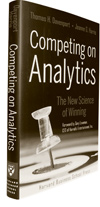Books in Brief
High-tech entrepreneurial experience, hidden assets, analytical sophistication, and China’s global ambitions.
(originally published by Booz & Company)Founders at Work: Stories of Startups’ Early Days
By Jessica Livingston
Apress, 2007
470 pages
 |
|
Photograph by Rick Schwab |
“Chance favors the prepared mind,” said French chemist Louis Pasteur, and Jessica Livingston has put together a collection of profiles that amply illustrate this maxim. Her Founders at Work: Stories of Startups’ Early Days is essential reading for anyone who is interested in the entrepreneurial process or has even thought about getting involved in a business startup. In 32 chapters of interviews, Livingston, a founding partner at the seed-stage venture firm Y Combinator, records the recollected tales of 29 men and three women who founded some of the hottest high-tech enterprises of the past 30 years. Although there is no summary of lessons from the stories, Livingston is an expert interviewer, asking just the right questions without ever becoming formulaic. The result is distilled wisdom about what it takes to succeed as an entrepreneur in the United States.
 People are the most important ingredient in a successful startup. As Joe Kraus, cofounder of Excite, puts it, “Venture capitalists…will tell you that they’d rather fund a great team than a great idea…. If they have a bad idea, great teams can figure out a better one…. Mediocre people even with a great idea can screw it up.”
People are the most important ingredient in a successful startup. As Joe Kraus, cofounder of Excite, puts it, “Venture capitalists…will tell you that they’d rather fund a great team than a great idea…. If they have a bad idea, great teams can figure out a better one…. Mediocre people even with a great idea can screw it up.”
How do you select the people? “Chemistry, mechanics, religion,” responds serial entrepreneur Ron Gruner, of Shareholder.com fame. That is, first you have to get along with them personally; then they must have the necessary skills; and last, they have to have a passion for the startup’s mission.
Business plans, according to Livingston’s subjects, are far from a necessity for running fledgling businesses; rather, they are employed almost exclusively as selling tools to gain support and resources from outsiders. What guides the businesses themselves is close, persistent attention to customer needs and an opportunistic ability to turn on a dime — even if it means throwing out the old business plan and devising a new one in the process. They offer varied perspectives, too, on the often ambivalent, sometimes vexed, relationship between startups and their investors, particularly venture capitalists (VCs). For the latter, unfavorable comments outnumber favorable ones by a wide margin.
It is also interesting how many of the entrepreneurs lack either the skills or the interest to manage the companies they create (which may account for their relationships with the VCs). Few are quite as reclusive as Steve Wozniak, cofounder of Apple Computer (who describes himself as “an engineer that works”), but many of the founders are impatient with activities that they regard as peripheral to the core competence of the business.
None of these entrepreneurs, in fact, seems to be in business to make money. Rather, in true entrepreneurial fashion, they want to “do something cool,” as several young founders put it, and change the world. Throughout the book are plenty of clues regarding how to nurture the spirit of entrepreneurship in established organizations — a quality the author call “startuppyness.”
Unstoppable: Finding Hidden Assets to Renew the Core and Fuel Profitable Growth
By Chris Zook
Harvard Business School Press, 2007
208 pages
 Chris Zook’s latest book emphasizes the unexploited opportunities that exist in every organization’s core business — a focus that Unstoppable shares with its predecessors, Profit from the Core (2001) and Beyond the Core (2004), both also from Harvard Business School Press. Unlike those two titles, this one shows how leaders can make changes in their business models while still running their businesses. Zook, who heads Bain & Company’s global strategy practice, supports his arguments with data drawn from studies, surveys, and interviews with executives around the world who have successfully redefined their core businesses.
Chris Zook’s latest book emphasizes the unexploited opportunities that exist in every organization’s core business — a focus that Unstoppable shares with its predecessors, Profit from the Core (2001) and Beyond the Core (2004), both also from Harvard Business School Press. Unlike those two titles, this one shows how leaders can make changes in their business models while still running their businesses. Zook, who heads Bain & Company’s global strategy practice, supports his arguments with data drawn from studies, surveys, and interviews with executives around the world who have successfully redefined their core businesses.
Zook’s key finding is that the renewal of a business’s core rarely requires leaps to distant markets or “big-bang” acquisitions: The opportunities lurk right under managers’ noses — if only they could see them. The first step to redefining the core of a business is to understand where one’s enterprise lies along what the author calls the Focus–Expand–Redefine cycle. This progression, through which business cores tend to move, helps managers understand the threats to the core and identify hidden assets. The hidden assets in any such redefinition are undervalued business platforms, untapped customer insights, and, most elusively, undeveloped capabilities. In uncovering all classes of hidden assets, it is important to be able to change “lenses,” looking at phenomena from different perspectives and at different levels of magnification.
The author draws four lessons from companies that have successfully renewed their core businesses: Redefinition starts with a core customer at the center of the new strategy; hidden assets must offer clear differentiation from the competition and tangible added value for the customer; seeing hidden assets requires the “cracking of mental screens,” as well as finding new vantage points; and, last, using hidden assets may require redefining the organization. These conclusions are hardly earth-shattering but, as the author points out, they are rather like the elements of a good golf swing: Each one sounds doable on its own, but the difficulty comes in doing them all at the same time and then repeating them.
Competing on Analytics: The New Science of Winning
By Thomas H. Davenport and Jeanne G. Harris
Harvard Business School Press, 2007
234 pages
 Too often, in their early applications to business, mathematical techniques were solutions in search of a class of neatly structured problems rarely encountered in the real world. But, as Thomas H. Davenport and Jeanne G. Harris make clear in Competing on Analytics: The New Science of Winning, the world has changed.
Too often, in their early applications to business, mathematical techniques were solutions in search of a class of neatly structured problems rarely encountered in the real world. But, as Thomas H. Davenport and Jeanne G. Harris make clear in Competing on Analytics: The New Science of Winning, the world has changed.
The catalysts for this change have been (1) an increase in our ability to capture, store, and analyze vast quantities of data, and (2) the emergence of a new generation of computer-literate executives. Analytics have developed into important tools for the extraction of competitive advantage by supplying rapid, specific feedback on the outcomes of management actions. Indeed, Davenport, the President’s Distinguished Professor of Information Technology and Management at Babson College, and Harris, executive research fellow and director of research for the Accenture Institute for High Performance Business, show how leading companies from a wide range of industries are now using a hugely expanded arsenal of mathematical techniques to drive their decisions and actions and compete more effectively.
The authors supply benchmarks against which firms can measure their analytical competence; the five levels range from the “analytically impaired” to “analytical competitors.” This latter category includes Harrah’s Entertainment, Capital One, Procter & Gamble, and the British supermarket chain Tesco. Organizations like these are using a broad variety of mathematical techniques both internally (in the areas of finance, manufacturing, research and development, and human resources) and externally (with customers and suppliers) to analyze, forecast, and optimize their decisions. The key factors in their analytic capability are technology itself, human components such as culture and leadership, and organizational elements such as performance management and strategy execution. In its stories and precepts, this book makes it clear that, although analytics are no substitute for business judgment, they enable leaders to exercise that judgment at much finer levels of discrimination.
The authors also list the potholes companies should avoid as they attempt to become more analytical. The most common is choosing the wrong problem or the wrong analytical technique. They say the biggest challenge is that objective criteria may pose a threat to powerful bureaucrats in organizations in which information is regarded as a source of power to be hoarded. With its high-level, comprehensive overview of the field of analytics, this book could become a worthy entry point for anyone interested in the subject.
Dragons at Your Door: How Chinese Cost Innovation Is Disrupting Global Competition
By Ming Zeng and Peter J. Williamson
Harvard Business School Press, 2007
240 pages
 It has long been known that there are a million Chinese villages in which people live in close proximity to birds and animals, and those villages thus offer ideal breeding grounds for new viruses capable of jumping from one species to another. It seems that a similar process is at work in the huge, fragmented Chinese economy, where disruptive business approaches are spreading from firm to firm and across industries. Ming Zeng, professor of strategy at Cheung Kong Graduate School of Business in China, and Peter J. Williamson, affiliate professor of international management and Asian business at INSEAD, have written a timely book on the threat of Chinese competition to established businesses throughout the world. In Dragons at Your Door: How Chinese Cost Innovation Is Disrupting Global Competition, they contend that many Chinese businesses have moved beyond competing on costs alone. Instead, they are offering high technology; unrivaled choice; and what used to be niche products, such as luxury appliances, at unmatchable low costs.
It has long been known that there are a million Chinese villages in which people live in close proximity to birds and animals, and those villages thus offer ideal breeding grounds for new viruses capable of jumping from one species to another. It seems that a similar process is at work in the huge, fragmented Chinese economy, where disruptive business approaches are spreading from firm to firm and across industries. Ming Zeng, professor of strategy at Cheung Kong Graduate School of Business in China, and Peter J. Williamson, affiliate professor of international management and Asian business at INSEAD, have written a timely book on the threat of Chinese competition to established businesses throughout the world. In Dragons at Your Door: How Chinese Cost Innovation Is Disrupting Global Competition, they contend that many Chinese businesses have moved beyond competing on costs alone. Instead, they are offering high technology; unrivaled choice; and what used to be niche products, such as luxury appliances, at unmatchable low costs.
The book is divided into five chapters that, respectively, explain how Chinese businesses evolved, detail the nature of their competitive advantage, describe how Chinese companies look for “loose bricks” in the facades of the businesses they attack, explore the Chinese competitors’ limitations, and present some possible responses from those threatened by these “dragons.” Most interesting are the numerous mini–case studies of Chinese firms that will be unfamiliar to many readers. China International Marine Containers (CIMC) Group, for example, with its slogan “learn, improve, disrupt,” dominates the global market for shipping containers. After starting at the commodity end of the business, it is now in every specialized niche — collapsible containers are an example — that its European competitors thought they could defend indefinitely. This move up the food chain is typical of the dragons. Haier, a name familiar to anyone who has bought a refrigerator recently, has turned the niche for wine refrigerators into a no-go area for its rivals. Often, this disruption is accomplished by substituting labor for complex capital equipment. BYD, a Chinese maker of rechargeable batteries, developed a nicad production line with just 6 percent of the capital cost of its Japanese equivalent but with 10 times the number of workers.
The dragons’ threat may have started in clothing and toys, but the authors clearly believe that it is moving inexorably from sophisticated manufactured goods to high-tech goods and services. At the same time, they argue that the dragons are starting to embrace whole value chains, from R&D through manufacturing to marketing. Given these assumptions, it is not surprising that the defense strategies offered by the authors are mostly of the “If you can’t beat ’em, join ’em” variety. That is, they argue that the only way to defeat the dragons is to go to China to take advantage of the same benefits the dragons have. This will not be news to many organizations — it is generally accepted that China is an important component of many corporate strategies.
Toward the end of the book, the authors’ portrayal of the Chinese dragons makes these companies seem rather too monolithic and omniscient, with their final victory inevitable. The book makes no mention of the changing contexts in which the dragons operate. (See “Context and Complexity,” by Edward Tse.) For example, in southern China in particular, health and welfare costs are rising sharply, and there is a growing shortage of Chinese managers and engineers. Developments like these, together with the steady increase in the value of the yuan, must slow the penetration of markets by Chinese-based competitors. At the national level China faces huge challenges: rebalancing its export-skewed economy and addressing the burgeoning social and institutional issues created by rapid economic growth. In the process, its corporate dragons will have to be “domesticated” — harnessed and put to the plow — and then will have to pull their full societal weight, just like their Western counterparts.![]()
Reprint No. 07312
Author profile:
David K. Hurst (david@davidkhurst.com) is a contributing editor of strategy+business. His writing has also appeared in the Harvard Business Review, the Financial Times, and other leading business publications. Hurst is author of Learning from the Links: Mastering Management Using Lessons from Golf (Free Press, 2002).

